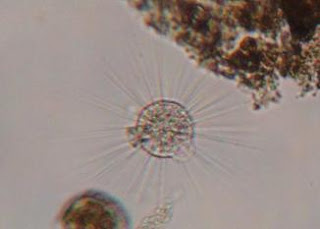Only two weeks into the experiment, and the growth is astounding. I imagine this is owed mostly to the decomposing food matter I identified that had been introduced to the MicroAquarium. I extracted the details from the class blog:
"Atison's Betta Food" added October 21 made by Ocean Nutrition, Aqua Pet Americas, 3528 West 500 South, Salt Lake City, UT 84104. Ingredients: Fish meal, wheat flower, soy meal, krill meal, minerals, vitamins and preservatives. Analysis: Crude Protein 36%; Crude fat 4.5%; Crude Fiber 3.5%; Moisture 8% and Ash 15%. Where previously locating an organism to view required a few seconds of probing, now tens of organisms were competing for food and space in any given section. Almost all of the organisms were many times smaller than a millimeter and much more diverse. Some of the same organisms were present. A few I had not identified before such as Uroglenopsis (
Pennak 1953 p. 41 Fig. G), Enteroplea
lacustris (
Pennak 1953 p. 200 Fig. E), Paramecium (
Pennak 1953 p. 25 Fig. E) were still thriving. I was able to even identify the large green sacs that I had noticed unmoving and scattered around the aquarium last time as rotifer eggs (
Pennak 1953 p. 174 Fig. A). In addition, the number of diatoms had significantly multiplied, but the varieties were relatively the same. A common one looked very similar to the rice-shaped one from last week, but with a budding protuberance on each narrow end.
Actinosphaerium
The first new organism I discovered feeding near the now deceased carnivorous plant was Euplotes (
Pennak 1953 p. 69 Fig. B). While I was observing him he swam right into the most interesting looking spherical organism with long flagella, Actinosphaerium (
Pennak 1953 p. 57 Fig. C). A plethora of organisms were gathered in the area encompassing the added food. One such organism was Holosticha
algivora (
Bick 1972 p. 19 Fig. 8C), drifting on the outskirts. Others I observed gathered near the feeding frenzy were Stylonychia
mytilus (
Bick 1972 p 174-175 Fig 88) and Thuricola (
Pennak 1953 p. 72 Fig. H). There were also many more rotifer eggs dispersed throughout this trafficked section at the top of the MicroAquarium.
Pennak RW. 1953. Fresh-water Invertebrates of the United States. New York. The Ronald Press Company. 25-200 p.
Bick H. 1972. Cilated Protozoa. Geneva, Switzerland. World Health Organization. 19-175 p.

No comments:
Post a Comment